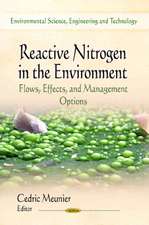Radioisotopic Methods in Hydrobiology
Autor Yuri I. Sorokinen Limba Engleză Paperback – 14 oct 2011
Preț: 642.51 lei
Preț vechi: 755.88 lei
-15% Nou
Puncte Express: 964
Preț estimativ în valută:
122.98€ • 133.63$ • 103.37£
122.98€ • 133.63$ • 103.37£
Carte tipărită la comandă
Livrare economică 21 aprilie-05 mai
Preluare comenzi: 021 569.72.76
Specificații
ISBN-13: 9783642641862
ISBN-10: 3642641865
Pagini: 340
Ilustrații: XIII, 321 p. 8 illus. in color.
Dimensiuni: 155 x 235 x 18 mm
Greutate: 0.48 kg
Ediția:Softcover reprint of the original 1st ed. 1999
Editura: Springer Berlin, Heidelberg
Colecția Springer
Locul publicării:Berlin, Heidelberg, Germany
ISBN-10: 3642641865
Pagini: 340
Ilustrații: XIII, 321 p. 8 illus. in color.
Dimensiuni: 155 x 235 x 18 mm
Greutate: 0.48 kg
Ediția:Softcover reprint of the original 1st ed. 1999
Editura: Springer Berlin, Heidelberg
Colecția Springer
Locul publicării:Berlin, Heidelberg, Germany
Public țintă
Professional/practitionerCuprins
1 General Features of Radioisotopic Methodology and Measurement of Radioactivity.- 1.1 Physical Background.- 1.2 Measurement of Radioactivity.- 2 The Radiocarbon Method to Estimate Primary Production in Aquatic Environments.- 2.1 Introduction.- 2.2 Historical Proceedings.- 2.3 Technique of Measuring Phytoplankton Primary Production.- 2.4 Faults in the Radiocarbon Method and Problems in its Calibration.- 2.5 Use of the Radiocarbon Method to Determine Primary Production by Benthic Hydrophytes and Their Associations.- 3 Radioisotopic Methods for the Study of Nutrition in Aquatic Animals.- 3.1 Introduction. Alternative Methods.- 3.2 General Principles.- 3.3 Preparation of Labeled Food.- 3.4 Analyses of Basic Values Needed for the Calculation of Intensity and Efficiency of Nutrition.- 3.5 Use of 14C for Assessment of Nutritional Problems in the Ecology and Physiology of Aquatic Animals.- 3.6 Measurements of Absolute Rates of Feeding, Food Assimilability, and Respiration.- 3.7 Concluding Remarks.- 4 Use of Radioisotopic Methodology in Aquatic Microbial Ecology.- 4.1 Introduction.- 4.2 Estimation of Relative Microbial Activity in Aquatic Habitats.- 4.3 Determination of the in situ Decomposition Rates.- 4.4 Determination of Microbial Production.- 5 Use of Radioisotopes to Study Biogeochemical Cycling of Elements in Aquatic Environments.- 5.1 Introduction.- 5.2 Study of Microbial Methane Oxidation Using 14C.- 5.3 Estimation of in situ Methane Production Rates.- 5.4 Measurement of Nitrification Rate with the 14CO2 Dark Uptake Method.- 5.5 Studying Sulfur Cycling with the Aid of 35S.- 5.6 Study of Sulfate Reduction.- 5.7 Study of the Dynamics of Phosphorus.- 6 Assay of Some Common Hydrobiological Techniques.- 6.1 Techniques for the Quantification Density of Microplankton Populations.- 6.2 Quantification of Mesozooplankton.- 6.3 Total Plankton Respiration, Stock of Labile Organic Matter, and its Turnover Time.- 6.4 Determination of Free H2S and Labile Sulfides in Bottom Sediments.- 6.5 Conclusion.- References.
Caracteristici
Collection of methods specifically for hydrobiologists and hydrochemists. They don't have to search in many different methods books to find the appropiriate methods for their specific needs









